continued.....
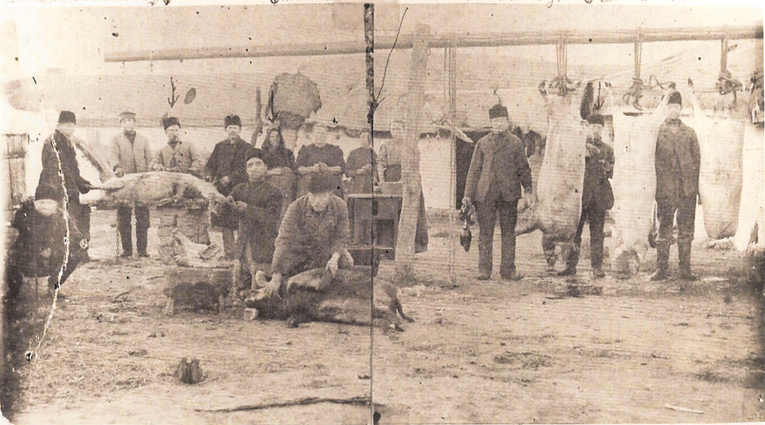
Harvesting Hogs
Crimea
1902
From left to right are
Martin Grischkoswki (3rd fr left)
Johanna, Grishkowsk. Blind (5th from left)
Johanna Grischkowski (mother but name not known, 7th from left)
Adam Anton Blind (2nd from right)
"I have seen the name Grishkowski spelled three others ways: Grischkowsky, Grischkoffsky and Grochowalsy/.
Whomever wrote on the picture used the Amercian spelling.
Roxie"
2 May 2012
-----------
Reinhold Schweikert , my grandmother's, Christina, nee Schweikert, Hein's uncle, who was married to Rosa Blind.
In Russia and when my mother, Lillian, nee Hein, Remmick, was young and living in Montana in the early 1920, the butchering of hogs traiditionaly took place in the autumn and / or early winter. Since the butchering wasn't done inside a building but outside, the temperature was what dicated the butchering because it could be too hot or freezing during the butchering.
The tools required were wooden troughs, huge metal contrainers in which boiling water was placed, gear to hang the heavy hog carcass, butchering knives that were bery sharp, special tool with a sharp blade for removing the bristly hairs of the hog, wooden barrels for stroing, pots, and baskets.
Everything of the hog would be saved and used in some fashion or another. So the cleaner the outside the more superior the taste of the end products (ham hock to pig ears, large.... and let us not foreget the headcheese....) was or is.
I will not go into the method of killing.
Once the hog was killed the blood was drained.....
Pictures can be worth a thousand words so I've blown up the various states taken from the Grischkowski and Blind photo.
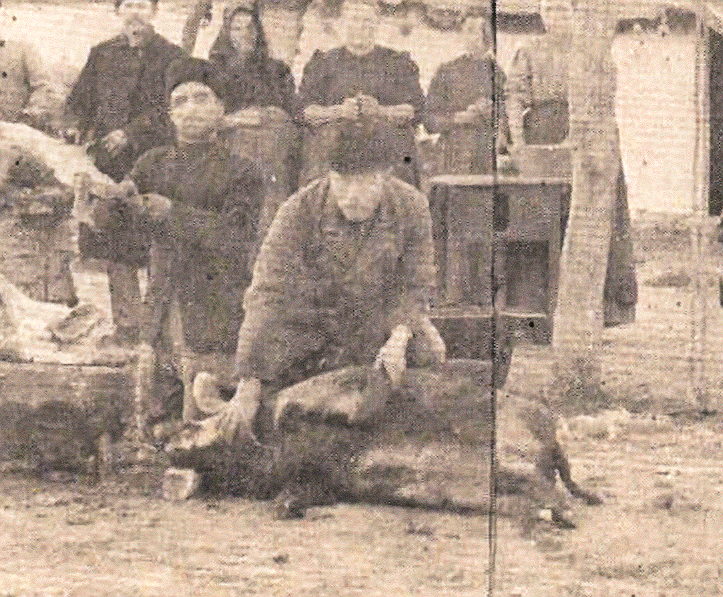
The stiff hairs of the hog is scraped away.
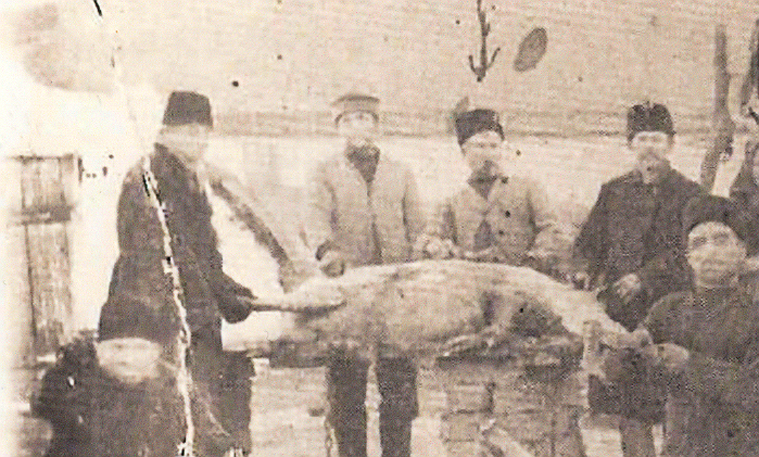
Hog is cleaned again and showered again with boiling warer and he remaining hairs are removed from tail to the snout.
Evidently some used a "pig scalder", which was like a large iron tub. in which the pig was lowered and scalded. The skin of the pig was soften and removing the hair was easier.
The hog is gutted and the various internal parts are separated and prepared. For example, the intestines will be cleaned and will be used later as casing for the ground pork and spices used in making sausages.
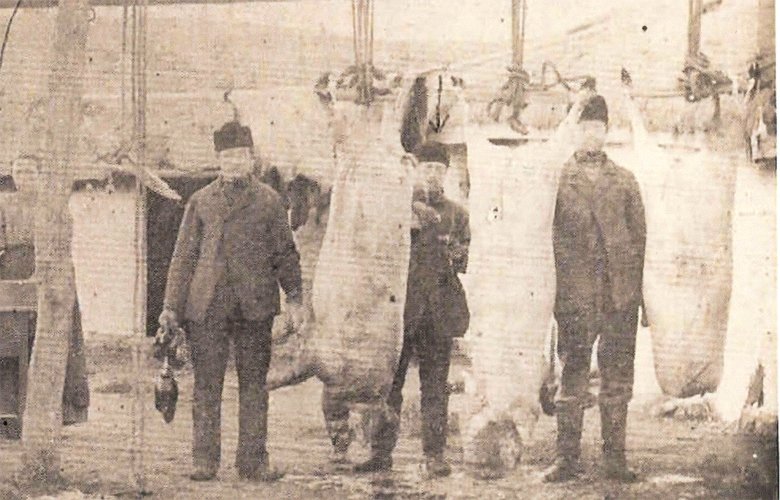
The various stages of hanging the hog are shown. The hog on the far right has lost it's legs and head. The hog is split in half and washed again to make sure all the blood and remaining inters are completely gone which prevents bacteria from growing. It is cooled down. This process makes it easier for those who cut the meat into hams, chops, bacon sides, etc..
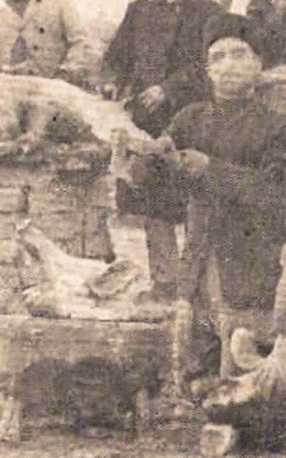
Head has been cleaned.
Head cheese is not a cheese. It is created after the head is cleaned The eyes, brain, tongue and ears will be removed. The head is boiled to form a meat jelly (terrine). There is the poor man's headcheese where only the scrapes are used and set into aspic. The meat and meat jelly congeals naturally but gelatin, which is made from cartilage, gives it that extra setting that will not melt. Before eating it is cooled to be sliced later and eaten with bread.
If the meat jelly is mixed with cream it is called a "Chaud-roid".
One can add better parts of the meat with vegetables or fruits.
Depending upon what is used the added flavors can be onions, pepper and, salt.
Most often the headcheese is combined with meat "cutoffs" such as the knuckles, tongue, heart and liver mixed with a variety of spices such as marjoram, garlic, caraway, pepper, cloves. Sometimes blood is added.
There is a version of pickled head cheese which is known as "souse".
The smoke house was important because this was where the preservation of pork was accomplished. The ham, shoulders, bacon sides, pork bellies were hung or placed on racks then smoked with hardwood. The smoke added flavor as well as dry cured the pork.
The bulk of the meat was ground and depending on what it was made into, spices and herbs were mixed and stuffed into the casing of the cleaned intestines.
The hog's bladder is like a balloon that can be tied off and used for carrying liquid. Here in the USA, a pig's bladder was used for the inside of a football that was held in leather.
Some of the fat was cut into small pieces with the skin still attached. This was stewed and fried. This produced what is called "cracklings" (fried pork rinds). When done properly, it can be delicious.
The remaining fat would be made into lard by heating it in a large iron pot over a fire until it is broken down into simmering grease. It was cooled and as it cooled it congealed. The lard would be stored in large tins with covers.
One of my favorite is "liver sausage" (Leberwurst) made, of course, from the hog's liver.
Foods that used blood hasn't been to high on my list of "must eat". They include: blood sausages, blood soup, blood pancakes, blood pudding (black pudding).... Using blood for gravy or meat sauces are more to my taste. In northern Germany there is a dish called "schwarzsauer" which is a mixture of vinegar, scraps, spices and sugar preserved in jars and heated before consumed.
What was left over were the bones that were not attached to chops, ribs, hams, shoulders and feet (they had been pickled)? In some areas it was traditional for the young unmarried girls to gather then take one of the clean bones, when the word was given they would throw the bone into the yard. The dogs would be waiting and the first bone to be snatched up by a dog would mean the girl who had thrown the bone would marry first. There are many other traditions which each group of people who were butchering. Some of it stem from the country such as German or Russia or Italian....
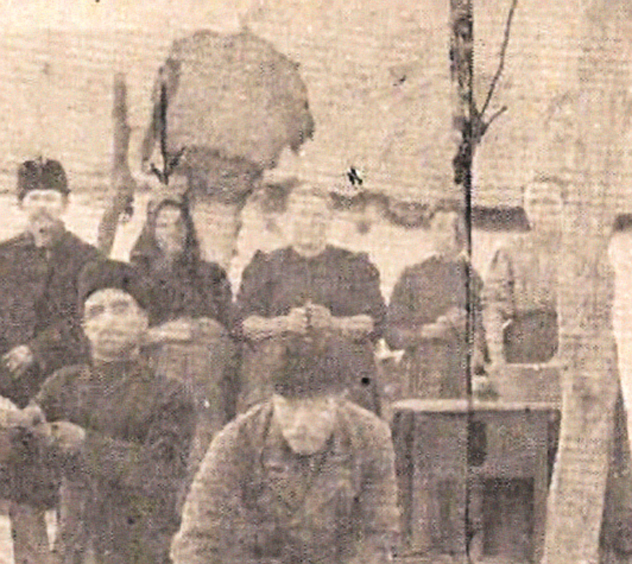
The jobs for men and women in those by-gone days was pretty well set. The men did the killing, butchering and grinding of th meat. The women were in charge of waiting, keeping the children busy, washing, scrubbing, cleaning the intestines, and cooking for the crew, the children and whoever else was present. Sometimes they were in charge of washing and scrubbing the tools (knives, axes, saws, razors, etc.) but the sharping was the men's duty.
Suckling pig is a piglet that is still feeding from it's mother. The ages are about two to six weeks. After the suckling is killed , gutted and cleaned, it is roasted whole and is prepared from special occasions.
I have never taken part in butchering a pig, my description above may not be completely accurate. But, it does give you a general description of what our ancestors, who were living on the country side, did during the butchering of a hog on a cool autumn or early winter day before we had butcher stores and refrigerators.